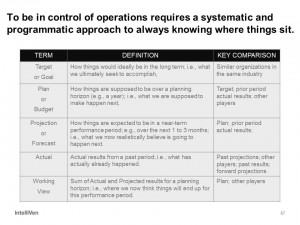Leaders who are in control of operations compare their organization’s actual performance results to:
- Past results to know whether their organization is trending up, down or sideways.
- The results other organizations that are doing things similar to theirs achieve in order to know how well they are doing relative to industry benchmarks, especially relative to those who do best what they are doing.
- Plan, budget, projection, or forecast in order to hold themselves accountable to what they said would happen.
- Target or goal to know if it is time to be done with what they are doing!



